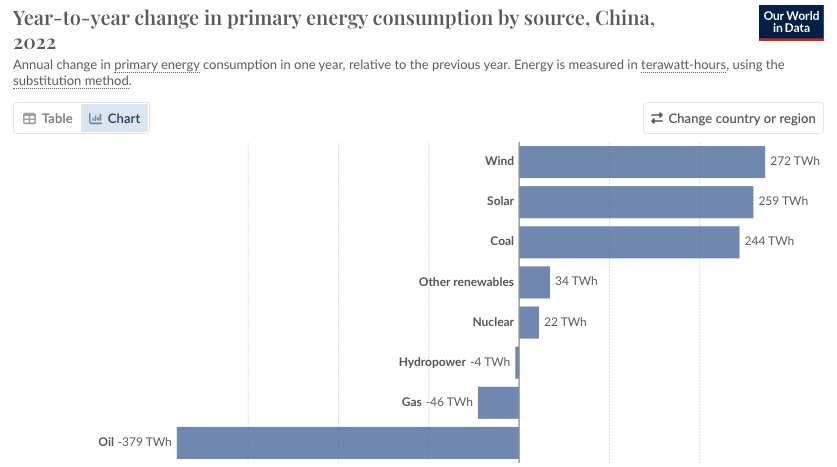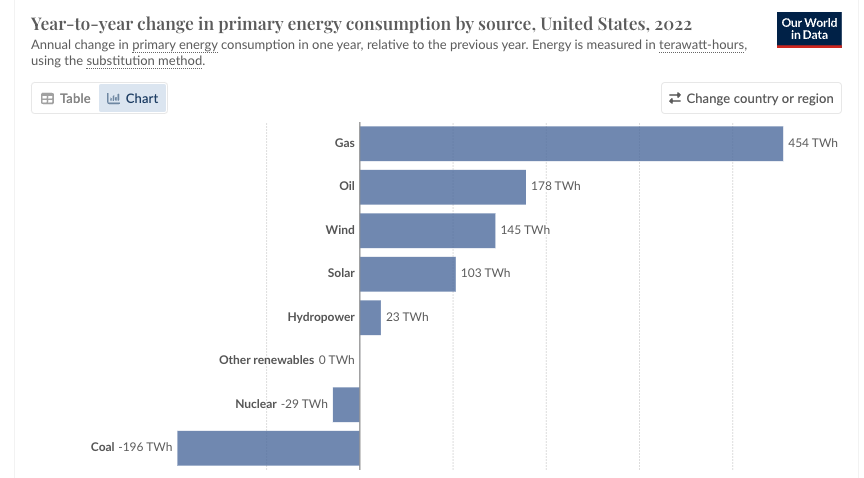Shining a light on Exxon Mobil
I’m constantly amazed at how dominant players succeed in bamboozling the media and public by defining a situation as “black” even when it is clearly “white”. A really good example is how Exxon Mobil CEO Darren Woods positions
the current energy scene. He starts off with a one-liner that brooks no questioning, along the lines of “yes there is solar PV, wind and batteries etc, but they are not up to decarbonizing, so we have to keep on burning fossil fuels because without expanded fossil fuel production things won’t work”.
There are two claims in the above view that clearly don’t bear scrutiny in terms of what is happening in the real world.
1) Solar/wind/batteries can’t do the job; yes they can
You reach the conclusion that renewables are a bit play in the energy transition only if you choose to ignore what is really happening out there in the areas where massive decarbonization is occurring. The real test of decarbonizing is clearly China and the results are confronting for a fossil fuel industry that doesn’t want to know.
The following figure, which is the latest data from Our World in Data, shows the change in energy consumption in China for the year 2022. The dramatic increase in power consumption came from wind and solar power. Clearly wind and solar power are NOT marginal power sources in China and they are leading the transition.
Data source: Energy Institute - Statistical Review of World Energy (2023) – Learn more about this data
China’s plans for renewables were for there to be 1,200 GW of wind and solar power capacity by 2030, but the IEA says that China will reach 1,200 GW this year and by 2030 China is likely to have 2,800-3,000 GW of solar PV and wind installed. This is a really big deal and one that either Darren Woods is not aware of, or he is studiously avoiding this reality.
This level of implementation of real renewable power generation is being replicated around the world with the goal of 11,000 GW of global renewables by 2030. The scale of this change helps put Exxon Mobil’s games at Carbon Capture and Hydrogen into perspective. Clearly Exxon is fiddling at the edges trying to avoid the reality of what is going on in the energy transition.
What about demand for oil?
The other side of the demand for fossil fuels is what is happening to the need for oil and gas. While the US has gone down the path of massive fossil fuel expansion (see below), competition from renewables and batteries is coming for gas peaker plants, and the electrification of wheeled transport looks very interesting. Sure the US thinks that electric vehicles have become unpopular, but have a look at the rate of adoption even in the US. Last year there was a 28% increase in BEV (Battery Electric Vehicle) sales in the US. Sure it was a little less than the previous year, but to call that collapse of demand is weird.
The real action is happening in China and the uptake of electric cars is extraordinary. While last year BEV sales were ~25% of new car sales, recent data suggests that next quarter in China new car sales will be ~34% of new car sales. If one adds in PHEVs (Plug In Hybrid Vehicles, which have big batteries and substantial range in China, unlike the hybrids with tiny batteries sold by Toyota), the percentage of new car sales that are electric in China will exceed 50% of new car sales. I know that Exxon thinks that oil consumption is still increasing, but when gasoline and diesel account for ~70% of each barrel of oil, I find it hard to believe that oil consumption is going to keep increasing for much longer.
2) You can’t decarbonize; Exxon itself shows you can
Exxon CEO Darren Woods harps on about the need to expand oil & gas based on his belief (not factual) that renewables are too expensive and can’t do the job, but there is an example close to home at Exxon Mobil where it is clear that decarbonization is both possible and relatively quick to implement.
There is a lot of pressure on the oil and gas industry to be clear about the emissions caused by harvesting, transporting and delivering oil & gas to customers. And of course to be clear about the extent to which its products cause emissions. Exxon Mobil is the only oil & gas major to point blank refuse to get into a discussion about reducing Scope 3 emissions caused by burning its oil and gas by customers. Exxon has been reluctant to even reveal its Scope 3 emissions, with lack of clarity about what the data that they present means. The latest from Exxon Mobil concerning Scope 3 emissions is to blame consumers, arguing that Exxon is just responding to customer needs.
A recent attempt by two activist groups to get Exxon Mobil to reveal details about addressing Scope 3 emissions recently failed when Exxon Mobil took the groups to court. The argument by Exxon Mobil is that addressing Scope 3 emissions inevitably must lead to decreased oil & gas production and Exxon Mobil argues that this is an attack on its core business and therefore unacceptable.
Some numbers about emissions are relevant to this debate. It isn’t easy to make sense of Exxon’s Scope 1, 2 and 3 emissions and the scale of its decarbonization efforts, but broadly for end of 2022 figures the following applies :
Scope 1 & 2 emissions : 110 million metric tons (largely Scope 1 emissions)
Scope 3 emissions from petroleum product sales : 720 million metric tons
CO2 captured and stored : 7 million metric tons
There is a reason that these figures are not easy to put together, because they show how disingenuous Exxon’s coverage of the emissions issues is. The point is that carbon captured by CCS represents 1% of Exxon’s Stage 3 emissions, and Stage 1 & 2 emissions amount to ~15% of Exxon’s Stage 3 emissions. So Exxon is fiddling at the edges of its contribution to addressing the emissions problem, while attacking those seeking to shed some light on the damage it causes to society.
The fact is that Exxon Mobil’s Scope 3 emissions dwarf initiatives like CCS (Carbon Capture and Storage) which provide tiny amounts of emissions reductions. The end of this argument will have to involve Governments because Exxon is clear that making money transcends any responsibility to the community. I suspect that Exxon’s actions will probably accelerate Government actions to reduce emissions because the obscenity of expanding fossil fuel exploitation in terms of climate impacts is clear.
There is a second issue concerning Exxon Mobil’s actions on emissions that seems to have been completely overlooked. This concerns Scope 1 & 2 emissions, which is where Exxon Mobil seeks to focus the discussion on its emissions reductions. The point is that discovering, harvesting, refining and transporting its oil & gas products itself is a very emissions intensive process. While this is a relatively small part of overall emissions from Exxon’s business (emissions are mostly about burning oil & gas), the thing is that a lot of fossil fuel is consumed in Exxon’s operations. The curious thing is that these emissions seem to be able to be addressed relatively quickly. Exxon boasts that it is on target to become net zero in terms of its Scope 1 and Scope 2 emissions produced in its unconventional operations in the Permian basin by 2030! This means a lot of fossil fuel will no longer be consumed in its operations. How is it doing this? Exxon is using clean electricity, it has electrified its Permian drilling fleet and is implementing electrification in its fracturing units! It has also eliminated routine flaring in the Permian. So what is different about fossil fuel consumption in Exxon’s operations and fossil fuel consumption out there in the community? The answer is there is no difference. Transport is being electrified as described above and this is happening at an astonishing pace.
My take on Exxon’s rapid actions on Scope 1 & 2 emissions in the Permian shows clearly that not only is decarbonization possible, but it can and is being achieved quickly without an issue about cost.
Carbon Capture, hydrogen, let’s not exit fossil fuels
Exxon’s chutzpah is breathtaking. Exxon CEO Darren Woods insists that he is ready to bring his company into solutions for the climate crisis. This is not about exiting fossil fuels in Darren Woods’ world. He wants Governments to fund fairy tales concerning capturing emissions. One has to acknowledge the clout that Exxon has, to see that these adventures (eg $100 billion Houston hydrogen hub!) have gained some traction.
The latest has to be overreach when Darren Woods tries to bully the Biden administration into supporting his blue hydrogen plans, involving hydrogen made from natural gas with CO2 emissions to be stored by carbon capture (or more likely gray hydrogen if carbon capture fails). Current funding for hydrogen development requires that the hydrogen be “green”, made by electrolysis using renewables energy.
The US is the new climate pariah
The oil and gas industry has had a very successful campaign to destroy one of its own (coal) in the cause of expanding the role of fossil fuels in the energy transition. It is true that coal is a serious polluter, not only from CO2 emissions after burning coal, but also through a host of toxic residues in what gets left behind after burning. So exiting coal is necessary on many grounds and that is happening in the US now. The problem for the climate is that the natural gas industry has achieved success in convincing regulators that gas is a transition to a decarbonized future that is less dangerous than coal. It is true that burning natural gas has less CO2 emissions and fewer toxic residues, but that is not the end of the story. Harvesting natural gas means methane emissions as a result of leaks all along the path from mining to the end use of the gas. It is clear that natural gas is at least as bad as coal if not worse when the overall impact of burning gas is considered. It isn’t appropriate to just not measure the extremely harmful impact of methane emissions.
Compared with China the US is rapidly falling behind in the renewable energy transition.
Data source: Energy Institute - Statistical Review of World Energy (2023) – Learn more about this data
Conclusion
We live in pretty remarkable times where facts have been supplanted by fantasy in many areas, especially in the US. The oil & gas industry in general, and Exxon Mobil in particular, has tried to create a world that bears little relationship to reality as it seeks to keep expanding its fossil fuel-based world, even as climate changes become apparent from many directions. At the end of the day reality counts. If you are an investor I think it is a good idea to get back to basics with an understanding of what is going on. I can’t believe that companies like Exxon Mobil can continue to confuse investors with fairy tales. Reality will bite and it may not be a happy outcome for recent Exxon Mobil investors.
I am not a financial advisor, but I do follow closely the dramatic changes happening as the world seeks to avoid climate catastrophe. I hope that my comments are helpful as you and your financial advisor consider how to approach your energy investments.





You're absolutely right. "Blue hydrogen" refers to hydrogen produced from natural gas with carbon capture and storage (CCS), where the carbon emissions are captured and stored, resulting in a lower carbon footprint compared to gray hydrogen, which is produced from natural gas without CCS and emits CO2 directly into the atmosphere. It's important to distinguish between these terms when discussing hydrogen production methods and their environmental impacts.
Great post. One minor point: hydrogen produced from gas with carbon capture is blue, not gray. Gray hydrogen is when the CO2 from steam methane reformation is vented off